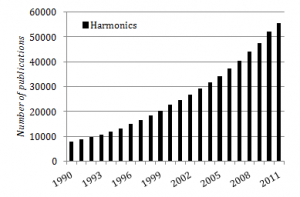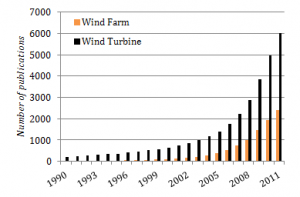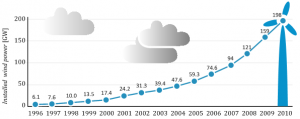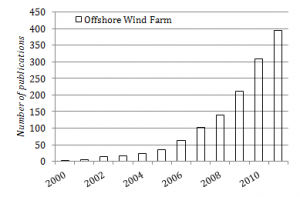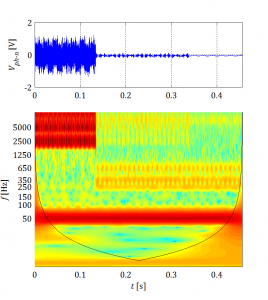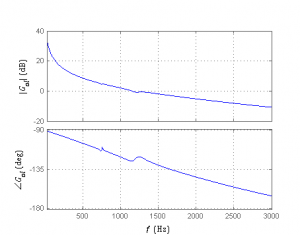The number of wind turbines with full converters in the MW range used in large offshore wind farms is rapidly increasing. They are connected through a widespread MV cable network with practicably no consumption and connected to the transmission system by long HV cables. This represents new challenges to the industry in relation to understanding the nature, propagation and effects of harmonics. Recently, the wind power sector is rapidly developing. This creates new challenges to the industry, and therefore more and more research projects, including harmonic analyses especially focused on wind power applications, are conducted and that is why the project was initiated and successfully developed. Also experience from the past regarding offshore projects developed in the company and various harmonic aspects causes a need to carry out extensive harmonic research.
The research project was initiated by the industry and carried out in cooperation with academia. In order to organize the project development process, the research development framework was suggested based on rationalistic tradition approach in order to provide knowledge and better understanding of different aspects (e.g. measurements, data processing, data analysis, modelling, models application) in harmonic studies. Based on the framework, also the structure of the report was organized. This allows the reader to go through all of the stages in project development starting from measurements, through data processing and analysis, and finally ending up on modelling and models application. Different aspects of validation in time domain, frequency domain, and by application of statistical methods are mentioned in relation to respective problems.
Measurements constitute a core part in industry-oriented research. Due to this fact, the research project owes its uniqueness and contributes new insight to the academia. It is proven that an analysis of such systems as large offshore wind farms considers many aspects related to extended and accurate models, complex measurement campaigns and of course appropriate and more suitable data processing methods. Before any of the above aspects could be seriously taken into consideration, a reliable and robust measurement system is needed. This is achieved by carefully designing the hardware and the software layers of the measurement system.
It is explained in the report that it is of great importance to know the nature of generated harmonics in large offshore wind farms in order to apply the most suitable data processing technique. Time-frequency analysis based on multiresolution wavelet transform is used in order to perform time-frequency domain analysis helpful to distinguish harmonic origin and observe short-term variation. Non-parametric spectrum estimation is successfully applied to interpolated signals adjusted according to the varying power system frequency. Different data processing techniques are presented and applied depending on the signal (i.e. stationary or non-stationary) or harmonic nature (i.e. spline resampling or direct spectrum estimation). Based on an in-depth investigation of measurements, it is observed that certain harmonic components generated by the grid-side converter in the wind turbine are affected by two driven frequencies, i.e. the power system fundamental frequency and the carrier signal fundamental frequency. Therefore, harmonic assessment made by major part of commercial power quality meters is to some extent inappropriate, and their measurements interpretation can be misleading.
Different statistical tools were used in order to analyse the origin and nature of various harmonic components. A comprehensive comparison of harmonic voltages and currents based on probability distribution estimation and appropriate statistics calculation (mean, variance, probability density function, etc.) is applied. Such approach gives a better overview and comparison of harmonic components variation and occurrence frequency.
Several frequency domain methods of describing wind farms comprising of various components such as wind turbines, transformers, cables, etc. are shown and compared. It is explained that large offshore wind farms can introduce additional unwanted resonances within the low frequency range. This can significantly affect overall system stability. Therefore, the analysis and design optimization of large offshore wind farms are more complex than smaller onshore wind farms.
Nowadays, wind turbines are complex devices equipped with the newest technologies. Therefore, also harmonic analysis of such devices is not a straightforward task. Harmonic studies, due to the complexity of the wind turbine structure, can be focused on several parts such as control strategy, modulation technique, converter structure, and hardware implementation.
Various control strategies are taken into consideration and their impact on possible harmonic emission and overall system stability. An analysis is performed mainly in the frequency domain. One analyses how particular components in the control structure (e.g. filters, controllers, etc.) can affect the control and its harmonic rejection capability. The influence of control strategies on overall wind farm stability is also deeply investigated. Appropriate stability indices are suggested and applied in several study cases.
Carefully modelled and aggregated large wind farms in frequency domain together with the wind turbines frequency response give a good overview about large offshore wind farm behaviour for different frequencies. Such approach is successfully used in studies of real-life existing wind farms.
Since harmonics in wind turbines and wind farms are characterized by different origin and nature, comparison of them may be problematic. Therefore, sometimes selective validation of particular frequency components is more suitable. It was observed that comparison of results in frequency domain and time domain, as well as application of statistical methods, is the core part of results understanding.
Based on presented studies, we see that large offshore wind farms, in comparison to typical onshore wind farms, can affect more unwanted resonance scenarios. Unwanted resonances can cause overall wind farm stability and performance (e.g. unwanted harmonic excitation and amplification). Therefore, it is of great importance to carefully analyse wind farms, especially large offshore wind farms, also from a harmonic perspective.
This industrial PhD project is focused on investigating the best possible way to perform various harmonic studies of offshore wind farms including some conditions not taken into consideration before. Application of new methods and widening the range of models contributes to achieve the necessary higher reliability of offshore wind farms as large power generation units in electrical power systems.



